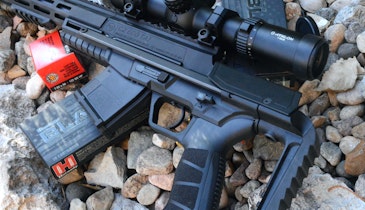Previously known as the Joint Army-Navy Nomenclature System (AN System) and the Joint Communications-Electronics Nomenclature System, it is used to get everyone on a common page when naming models of radios and other electronic equipment. Although the process of creating a standard designation system across the U.S. military began in World War II, to varying degrees of success, it wasn’t until 1957 that JTEDS was formalized as MIL-STD-196. We are currently on the seventh iteration of that standard, and since 1998, it has been paperless, and you may see it referred to as the Joint Electronics Type Designation Automated System. Despite the Army Navy designation, all of the services, including the Coast Guard, use it, as does the National Security Agency.
JETDS uses a combination of Type Designation and an Item Name. You’ll note that military radio designations begin with AN for Army Navy followed by a slash. The three letters after the slash designate the role of the item. Many who served in the military over the past few decades have used the Single Channel Ground and Airborne Radio System (SINCGARS) family’s AN/PRC-119. PRC is used to designate Portable, Radio, and Communications. Mounted in a vehicle, the “P” would become a “V” or, if installed on an aircraft, an “A” would be used. There are various combinations of designator letters that can be referenced easily online. Accessories like antennas, power supplies, and security devices use other designators to denote model. Below is an example:
- AN/PRC-119A (X, Y or Z) (V) AN/ - indicates JETDS System P - indicates the Installation R - indicates the Type of Equipment C - indicates the Purpose
- 119 - indicates the model number
- A - indicates the modification letter
- X, Y or Z - indicates a change in voltage, phase or frequency
- (V) - indicates a Variable Grouping
That “V” suffix in the nomenclature can be tricky. It stands for “variable,” is always in parentheses, and denotes that there are multiple configurations of the item.
GIs have a habit of creating nicknames or turning complex acronyms into words. Take for instance radios. Almost all military personnel use a radio at one point or another during their service, even if only during basic training. Older veterans will remember the AN/PRC-25 or its follow-on, the AN/PRC-77. Using the JTEDS designation, these become “Prick 25” and “Prick 77” respectively. Consequently, the newer, frequency hopping SINCGARS radio is known as a “Prick-one-nineteen.”
It seems like this system would be straightforward, but it’s not. Designations can seem arbitrary and make you wonder if the person who designated the nomenclature actually knew the function.
During my enlisted service in the Army, I was an Electronic Warfare/Signal Intelligence Voice Interceptor, which is a long-winded way of saying that I used my foreign language skills and intelligence training, along with a wide range of electronic equipment, including radios, to collect and report enemy signals, essentially to listen in on their communications.
I used a variety of direction-finding systems, including the PRD-10, PRD-11, and PRD-13. All of those were man portable, radio direction finders. Pretty straightforward stuff, all easy to discern based on the designation. However, I also used the TRQ-30 and the TRQ-32. By JTEDS those should be Transportable, Radio, Special Purpose sets. Okay, maybe the name is innocuous to throw the enemy off so they don’t know what it does, but that never really works, does it? While both the “Turkey 30” and “Turkey 32” (I told you GIs come up with words for acronyms) were radio direction finders, used to locate enemy radios, the first was a backpack-sized system designed in the ’60s that relied on 30 D-sized batteries for power (that is not a typo) and the second system was mounted in a climate-controlled box and mounted to the back of a Chevy pickup. If you find yourself interested in oddball military electronics, you’ll run across all kinds of crazy designations like this.
Granted, it’s a lot to take in, but now I’m going to explain why I’ve gone over all of this. It’s been a setup to tell you about an Army hazing ritual which has been around for ages. It’s a prank pulled on new soldiers, sending them on errands to retrieve various fictitious pieces of equipment, such as Chemlight batteries, prop wash, or the keys to the drop zone. The items vary based on the type of unit, its mission, location, and the imagination of the troops. Oftentimes, others are in on the gag and sometimes they aren’t, such as the case of the PRC-E7.
If you recall, the acronym “PRC” is pronounced “prick” and E7 is the pay grade of a sergeant first class, in charge of a platoon or section. Usually, the unsuspecting private is sent to this office or that to fetch the “Prick-E-7” at which point a rather surly senior noncomm gets in on the act and gives the soldier a hard time. However, if a squad leader wants to mess with his boss or someone else’s, they will send the private on the expedition anyway. Hilarity generally ensues. All of the old hands know the joke, but rarely is a platoon sergeant happy to be called a “prick,” even if the messenger innocently thinks he’s picking up a radio.
So next time you run across some crazy trigraph followed by a number, know that the combination likely identifies a piece of electronics equipment in the U.S. military inventory, particularly if it’s proceeded by the letters “AN.” For sure, you’ll also think, if just for a second or two, about that poor recruit, sent off on a fool’s errand to round up a crotchety NCO.





